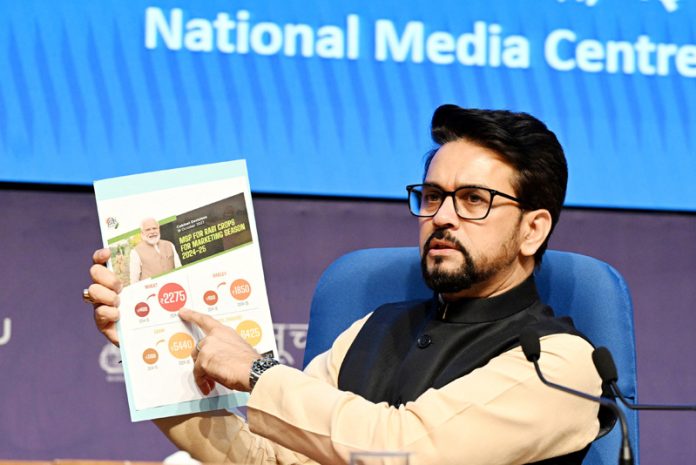
DA up by 4%, wheat MSP by Rs 150 per quintal
78 days bonus for N-G Rly employees
NEW DELHI, Oct 18:
The Government today approved setting up of a Rs 20,773.70 crore-transmission line for evacuation of solar power from a 13 GW renewable energy project in Ladakh to Kaithal in Haryana.
Prime Minister Narendra Modi, during his Independence Day Speech, had announced setting up of a 7.5 GW solar park in Ladakh.
After extensive field survey, the Ministry of New and Renewable Energy (MNRE) prepared a plan to set up 13 GW renewable energy generation capacity along with 12 GWh Battery Energy Storage System (BESS) in Pang, Ladakh, an official release said.
For evacuating the huge quantum of power, it will be necessary to create an inter-state transmission infrastructure.
Information & Broadcasting Minister Anurag Thakur said the Cabinet Committee on Economic Affairs (CCEA) has approved the project on Green Energy Corridor (GEC) Phase-II – Inter-State Transmission System (ISTS) for the 13 GW renewable energy project in Ladakh.
The project is targeted to be set up by financial year 2029-30 with a total estimated cost of Rs 20,773.70 crore and 40 per cent central financial assistance estimated at Rs 8,309.48 crore.
The project is expected to be awarded by March 2025, sources said.
The transmission line for evacuating the power will pass through Himachal Pradesh and Punjab up to Kaithal in Haryana where it will be integrated with the national grid.
An interconnection is also planned from the project in Leh to existing Ladakh grid so as to ensure reliable power supply to the Ladakh.
It will also be connected to Leh-Alusteng-Srinagar line to provide power to Jammu & Kashmir. The project will entail setting up of 713 km transmission lines (including 480 km HVDC line) and 5 GW capacity of HVDC terminal each at Pang (Ladakh) and Kaithal (Haryana), the release said.
The project will contribute to achieving the target of 500 GW of installed electricity capacity from non-fossil fuels by year 2030, it added.
Further, the project will generate large direct and indirect employment opportunities for both skilled and unskilled personnel in power and other related sectors, especially in Ladakh region.
This project is in addition to Intra-State Transmission System Green Energy Corridor Phase-II (InSTS GEC-II), which is already under implementation in the states of Gujarat, Himachal Pradesh, Karnataka, Kerala, Rajasthan, Tamil Nadu and Uttar Pradesh for grid integration and power evacuation of approximately 20 GW.
According to the sources, the setting up of the transmission line poses major challenges as the work involves construction at altitude of up to 4,700 metre above mean sea level and ambient temperatures below -35 degree celsius, low air density and very low atmospheric oxygen levels.
Meanwhile, the Union Cabinet also increased the dearness allowance and dearness relief by 4 percentage points to 46 per cent to benefit 48.67 lakh Central Government employees and 67.95 lakh pensioners.
The release of the additional instalment of dearness allowance and dearness relief will be applicable from July 1, 2023, Information & Broadcasting Minister Anurag Thakur told reporters after the meeting of the Union Cabinet.
This increase is in accordance with the accepted formula, based on the recommendations of the 7th Central Pay Commission.
Ahead of assembly polls in key wheat growing States, the Government announced an increase in the minimum support price (MSP) of wheat by Rs 150 to Rs 2,275 per quintal for the 2024-25 marketing season.
This is the highest increase by the Narendra Modi-led Government since it came to power in 2014.
A decision in this regard was taken in the meeting of the Cabinet Committee on Economic Affairs (CCEA) chaired by Prime Minister Narendra Modi.
Currently, the MSP on wheat stands at Rs 2,125 per quintal for the 2023-24 marketing season (April-March).
Briefing media, Thakur said the CCEA has approved the increase in the MSP for all mandated rabi crops for 2024-25 marketing season.
“Based on the CACP recommendation, we have increased the MSP of six rabi crops. Wheat MSP has been increased by Rs 150 per quintal,” he said.
The support price of wheat has been increased to Rs 2,275 per cent quintal for 2024-25 marketing season, from Rs 2,125 per quintal in 2023-24, he added.
Wheat is the main rabi (winter) crop, sowing of which begins in October, while harvesting in April.
MSP is the minimum rate ensured to protect the interest of farmers and below this rate the grain is not purchased by the Government procurement agencies.
Meanwhile, Railway employees will receive a bonus equivalent to their 78 days’ salaries, a move that will benefit more than 11.07 lakh non-gazetted staff of the national transporter, the Government announced today.
“The Union Cabinet, chaired by Prime Minister Narendra Modi, has approved a Productivity Linked Bonus (PLB), equivalent to 78 days’ wages, for the financial year 2022-23 for all eligible non-gazetted Railway employees,” Anurag Thakur said.
The decision will benefit track maintainers, loco pilots, train managers (guards), station masters, supervisors, technicians, technician helpers, pointsmen, ministerial staff and other Group ‘C’ staff, excluding the RPF and RPSF personnel.
The payment of the bonus is expected to cost the exchequer Rs 1,968.87 crore, Thakur said.
“In recognition of an excellent performance by the railway staff, the Union Government has approved the payment of a PLB of Rs 1,968.87 crore to 11,07,346 railway employees. The performance of the railways in the year 2022-2023 was very good. The railways loaded a record cargo of 1,509 million tonnes and carried nearly 6.5 billion (650 crore) passengers,” an official statement said.
It added that among the factors that contributed to the record performance are an improvement in the infrastructure due to the infusion of capital expenditure by the Government in the railways, efficiency in operations and better technology.
The payment of the PLB will act as an incentive to motivate the railway employees for working towards further improvement in their performance, the statement said. (PTI)

